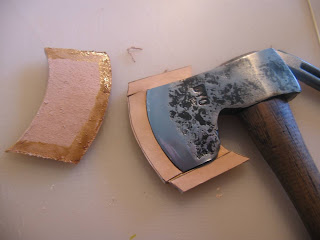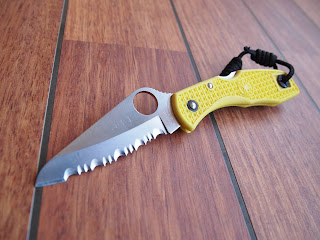Equipment
This is all the hardware you will need to make this axe sheath:
- 2 stitching needles
- Heavy scissors / shears
- Ruler
- Fork or overstitch wheel
- Stanley knife
- Bone burnisher
- Heavy awl
- #2 edger
- Belt sander / grinder
- Drill press
- Needle nose pliers
- 3mm veg tanned saddle leather (minimum)
- Artificial sinew for stitching
- Dye (if you intend to colour the leather)
- 120 grit sand paper
- Contact cement
- Beeswax or saddle soap for burnishing
- Paper / cardboard and a pencil
Step 1
Take a sheet of paper and lay it on a nice flat surface. Trace around the edge of the axe and about 2 - 3 inches up towards the eye. Outline this template, giving yourself about half an inch. This extra room is necessary as you will need to glue and stitch in a spacer. This extra width allows the glue to properly grip all surfaces.
Step 2
Cut out the template. Trace the template onto the leather twice. REMEMBER, you will need to reverse the template so you don't have 2 of the same side. Also bare in mind that you want the nice side of the leather to be facing outwards. I usually use a ballpoint pen to draw onto the leather. It works much better than a pencil.
Step 3
Cut out the leather templates using scissors / shears and the ruler and Stanley knife.
Step 4
Since we added half an inch to the blade outline, you should have an outline of what the spacer will look like. Cut this out.
Step 5
If we leave the spacer outline whole when cutting it from the main leather piece, we will create more unusable leather as it's such an awkward shape. I chose to cut it into smaller pieces to reduce waste. At this point, it is also prudent to edge the leather that will be near the opening on the inside. The picture was taken before I had done this. Also, take a moment to check that everything lines up and there are no glaring problems with the fit of the axe in the sheath so far.
Step 6
Apply contact cement to leather. Don't apply it to both sides of the spacers right away. One side will do, plus the portion that will make contact with the other pieces of the spacer. Make sure you don't over apply the glue. Use a small amount but work it into the grain of the leather. In the above picture you can see the edging has been done. Avoid doing the edging where you will glue the spacers as this will result in a gap.
Step 7
Once the glue is tacky to the touch, press the pieces together. make sure the spacers are pressed firmly together. If you are sloppy at this point, there will be gaps that you won't be able to hide. At this point check the fit again. It should be quite tight as friction will be responsible for holding the sheath onto the axe. Even though it is glued, minor adjustments can still be made as the glue is flexible.
Step 8
Apply contact cement to the other side of the spacer. Once this is dry, attach the other side of the sheath, pressing firmly together.
Step 9
At this point the 2 halves and the spacer are firmly held in place by the glue. Mark a light line where you wish the stitching to be. Using your fork or overstitch wheel, mark around the sheath. Now it's time to move to the awl or drill press to make the holes. Because I prefer to over-engineer my sheaths, using an awl is close to impossible. It's extremely hard work and rarely leaves a good result. I use a 1mm drill bit and drill out the leather instead. Be sure not to stray so that you miss the spacer.
Step 10
Now the stitching begins. I stitch using the saddle stitch method. This requires that you put a needle on each end of the artificial sinew. Threading one needle into the hole, pull it through until you have reached the halfway point of the thread. Now you move onto the next hole. First put one needle through, so that both needles and thread are on the same side, now thread the other needle through. You are stitching a kind of "figure 8". Needle nose pliers help here as it can get difficult, especially when back stitching at the start. Here is a great tutorial from Brirish blades to help demonstrate the method:
Saddle stitch tutorial
You can dye the leather before or after stitching. You generally get a better result if you dye before however I didn't as it makes it harder to see what I am doing in the photos.
I always back stitch first. I start 4 holes from the last hole and stitch to the end, then stitch back up again, all the way to the other end. When I get to the other end I stitch back 4 holes again, then clip the thread. This makes the ends stronger and more resistant to seperating.
In this photo I have reached the end, now I have to back stitch.
Once I have back stitched, I clip the threads very close and I am now done with the stitching.
Step 11
At this point the sheath looks pretty rough. This is where the belt grinder / sander comes into it. Use the sander / grinder to grind the irregularities so that you are left with smooth edges. You can also use 120 grit sand paper for this, it just takes longer. Once this is done, go around the sheath with the edger. You will be left with this:
Step 12
If you have left off dying the leather, now is the time to do it. Dying needs to be done before you burnish the edges. I don't use a wool swab. I just use a piece of sponge dabbed into dye and then dab that onto the leather. I make sure to get it inside the sheath so I am not left with the natural colour contrasting against the dark dye. Once the dye is dry, it's time to burnish the leather.
Step 13
This is the final stage. Rub your thumb against the edges first one way, then the other. You will see that the leather has a natural grain orientation. Remember which way the grain naturally wants to lay flat. Now, using a little saliva on the tongue, give the edge you want to burnish a lick. It should now be moist. Now apply your beeswax or saddlesoap. if you use beeswax like me, you will need to rub quite vigerously to rub it into the grain. wetting the edge with saliva first makes the fibers more supple, giving a better finish in the end. Once you have finished applying the wax / saddle soap give the edge another lick so that the burnishing tool will slide easier (not necessary if using saddle soap). Now, using your bone burnishing tool (which can bee a piece of hardwood or even a bit of lambshank bone), rub the edge back and forth quickly. You will see that a shiny finish is starting to appear. Now start to rub the edge in the direction that you noted the fibers naturally wanted to go. You will have to press firmly. Do this to all the edges. Give the edge a final polish and you are done. This is how mine turned out.
Keep in mind this is the most basic sheath you can make. If I was to make it prettier, I would have grooved the leather so that the thread sat flush rather than proud of the leather. I hope you enjoyed this tutorial and found it useful. The more leatherwork you do, the faster you will get. This took me about 40 minutes to make with interruptions.






































